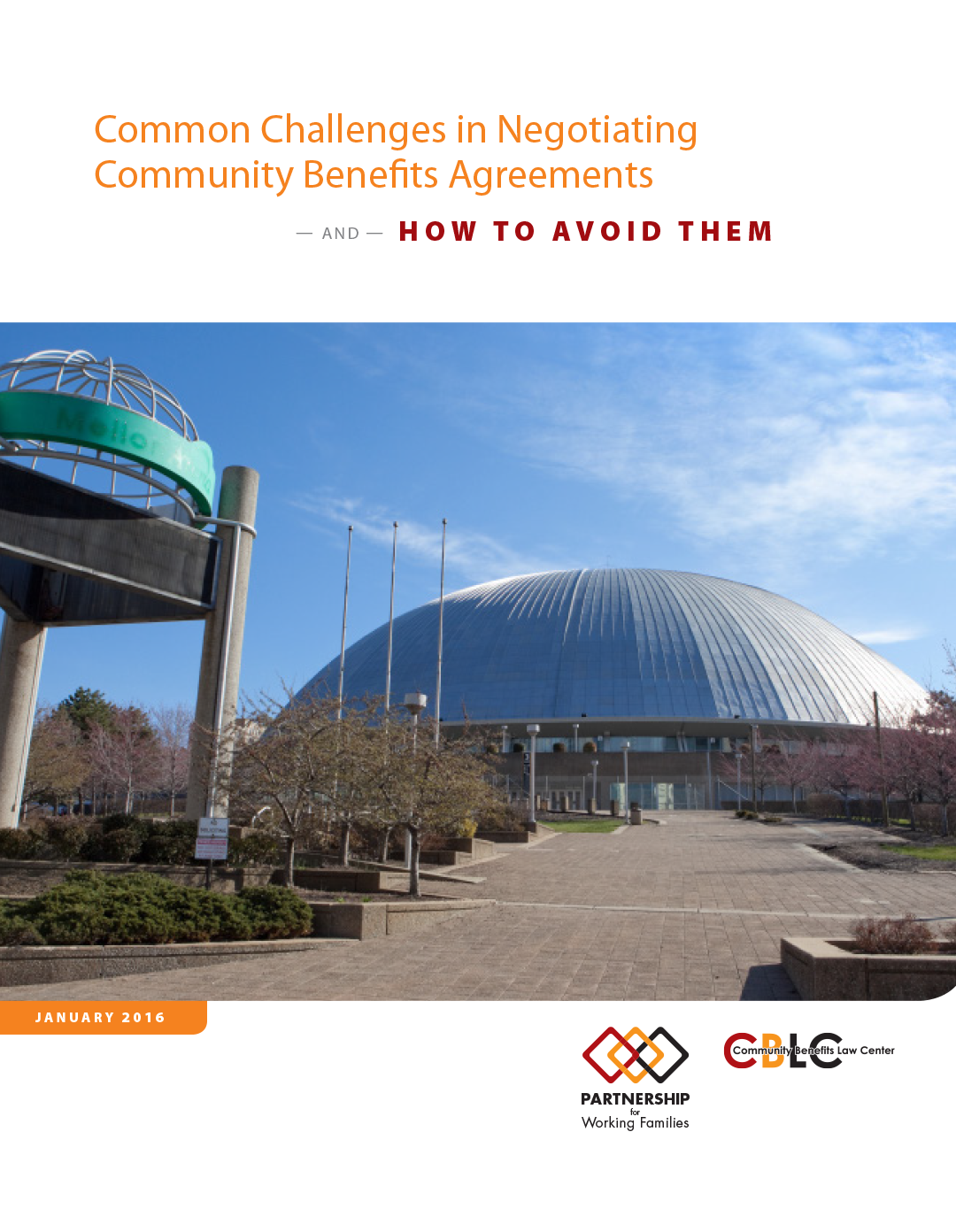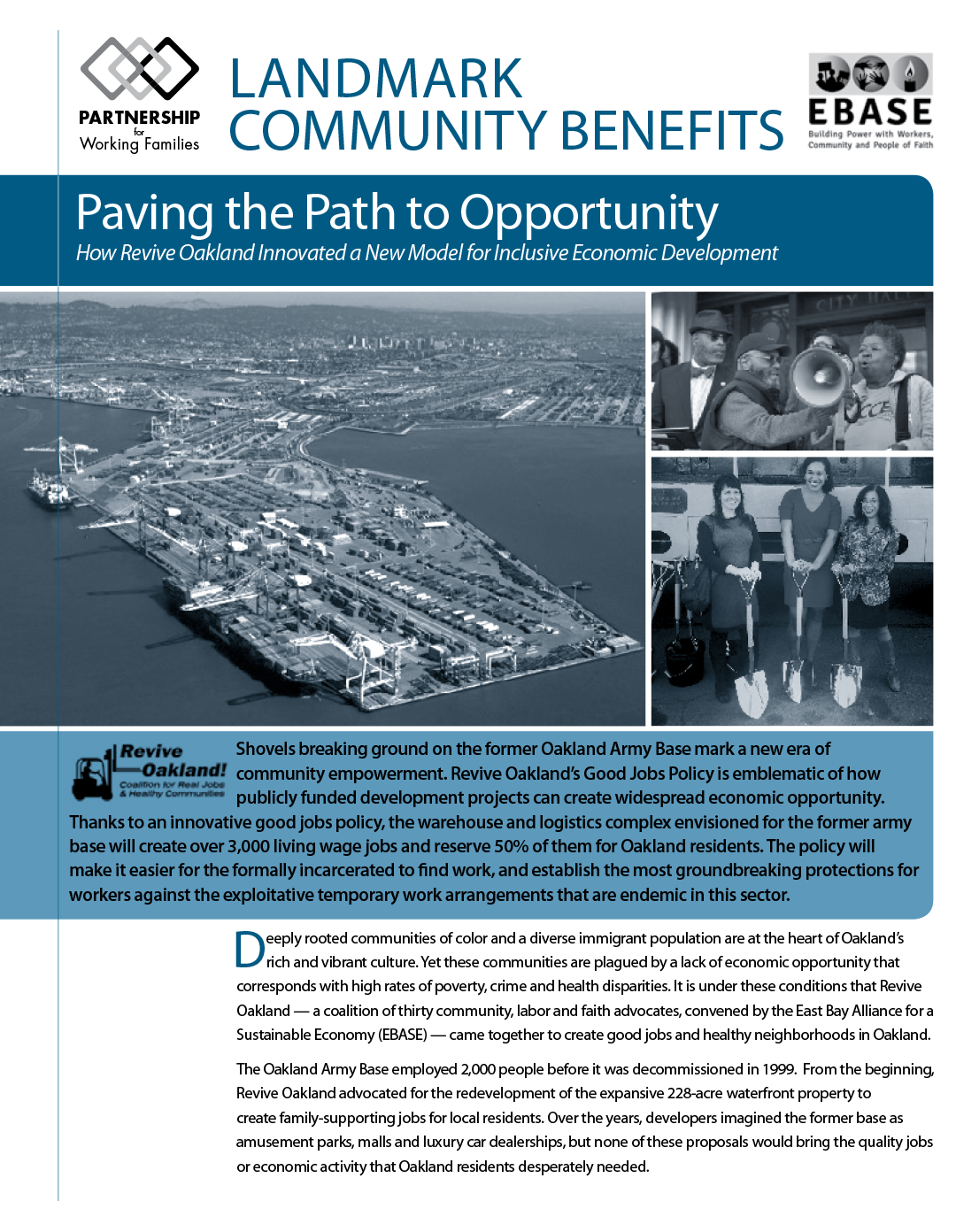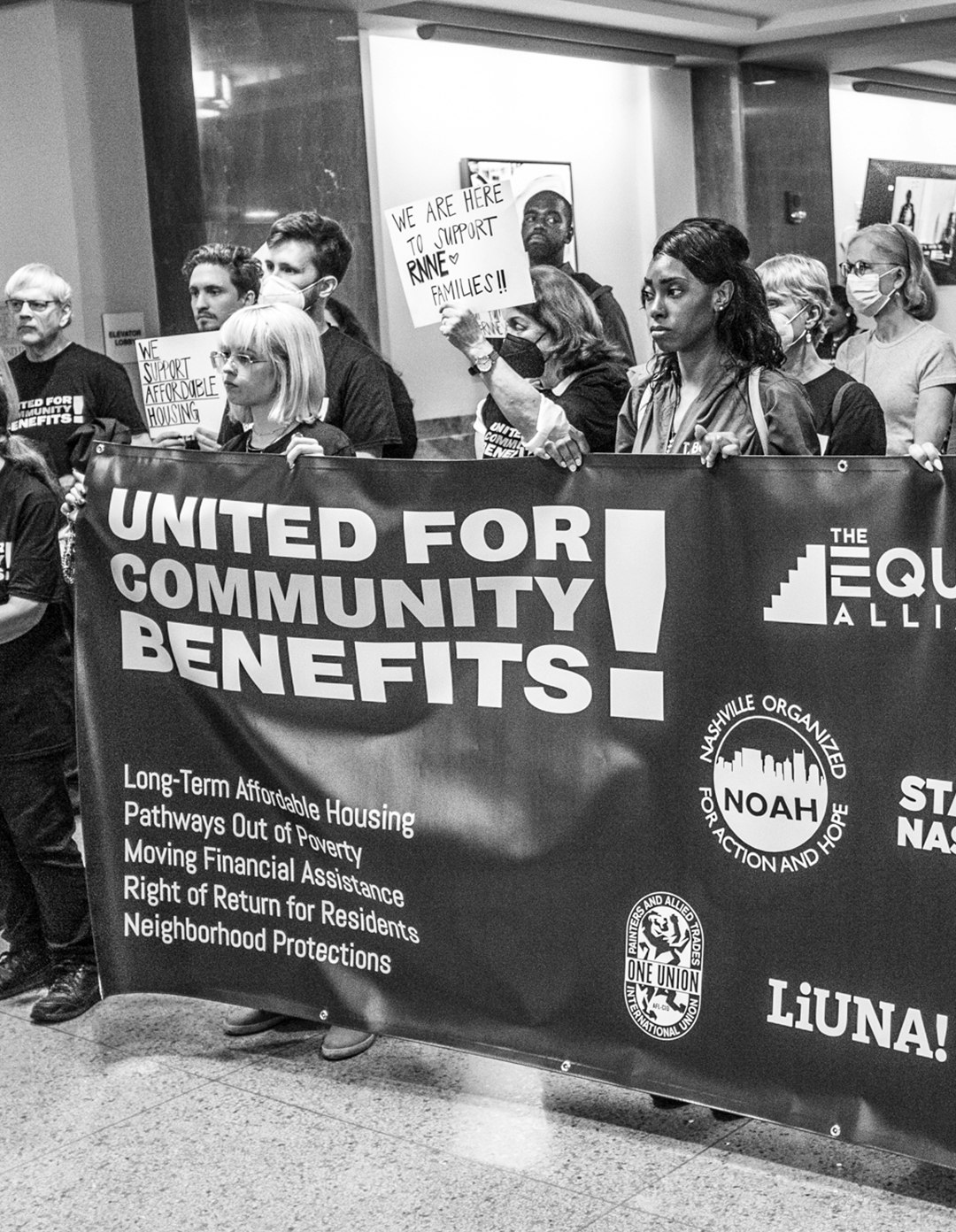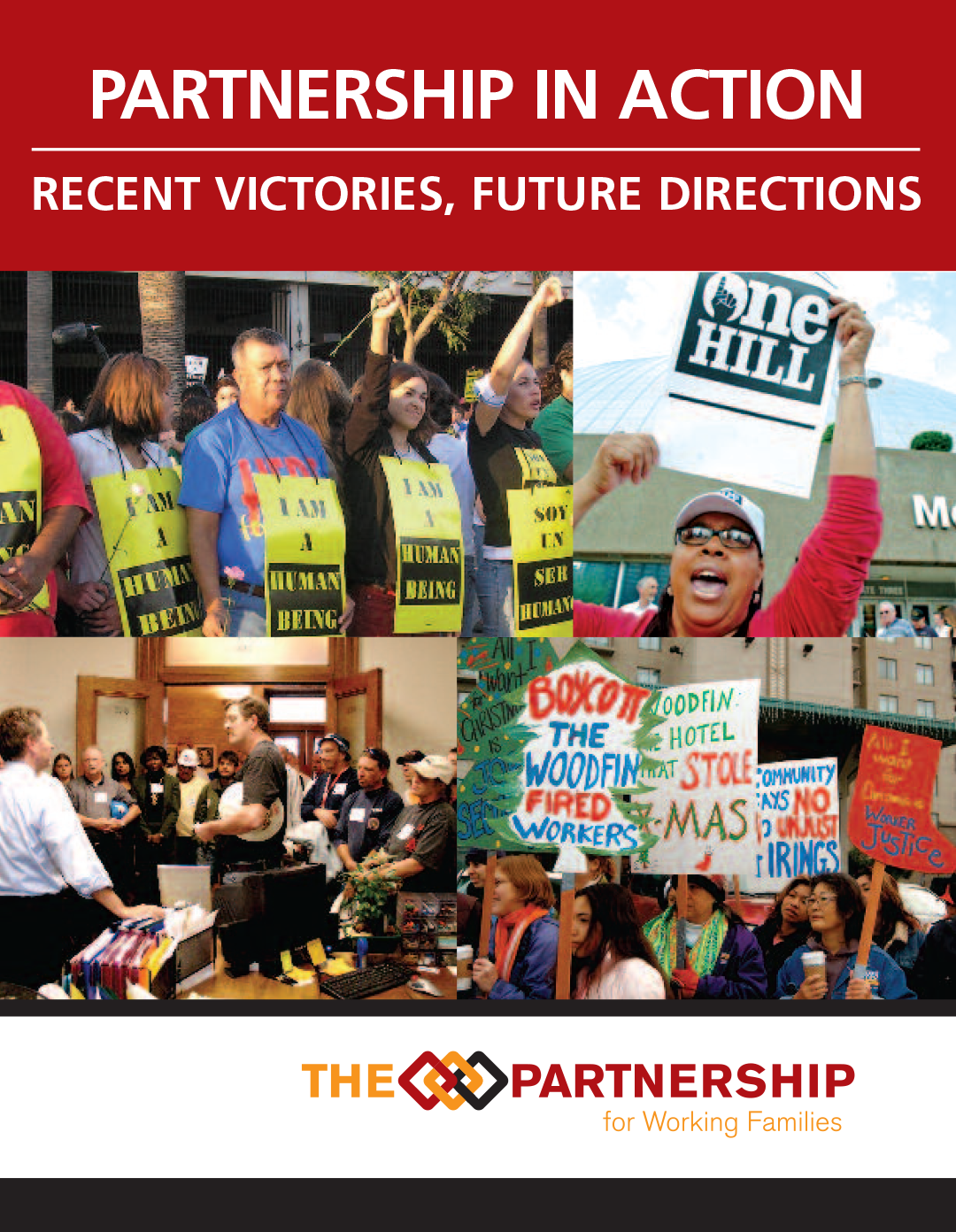CBAs Currently in Effect
Nashville Soccer Stadium Development CBA
In 2018, Stand Up Nashville (SUN), a coalition of community, labor and faith-based groups, negotiated the first private Community Benefits Agreement in Tennessee on a proposed Major League Soccer (MLS) stadium development on the Tennessee State Fairgrounds. Nashville Soccer Holdings (a joint partnership between area investor John Ingram and MarketStreet Enterprises) are developing a 10-acre mixed use development adjacent to the 8-acre proposed $275 million 30,000-seat stadium for a new MLS team. Metro Nashville Government issued $255 million in revenue bonds for the stadium, $25 million in general obligation bonds for fairgrounds infrastructure upgrades and an additional $25 million for fairgrounds facility improvements. The ownership team, under a 30-year stadium lease agreement, would pay the city $25 million in cash and $9 million a year to pay off Metro’s stadium debt. Sales tax revenue and dollars from a ticket tax would make up the additional $4 million in annual $13 million debt payments. The city would be on the hook to pay the difference if the sales tax and ticket tax revenue fall short.
After months of intense negotiations and community organizing reached a landmark agreement that sets a new standard for development in Tennessee, that includes the following commitments:
Affordable Housing
- 20% of all housing units built at the development site will be set aside as Affordable and Workforce Housing
- A commitment to 3 bedroom units that reflect the need for family housing in our city.
Wage Floor
- NSH agrees to directly hire stadium workers (ushers, ticket takers, box office janitorial, custodial, maintenance, field maintenance employees) and pay them at least $15.50 an hour.
- The establishment of a first-of-its kind targeted hiring program in Nashville with dedicated staff that will connect individuals with barriers to employment to future job opportunities at the stadium.
Community Services & Amenities
- 4,000 sq ft will go to a childcare facility, which will operate on a sliding scale.
- 4,000 sq ft will go to establishing micro-unit retail spaces for artisans and local small businesses at a reduced rental rate.
- NSH will host annual coaching clinics for Metro School and other youth soccer coaches and donate soccer equipment to these programs.
Jobs and Workforce Development
- Mandatory safety training for all construction workers and supervisors.
Leveling the playing field for responsible contractors that provide safe, thriving careers for their employees.
- Construction careers for individuals with barriers to employment, especially from Promise Zones.
- Inclusion of minority contractors.
Community Advisory Committee
A Joint Committee will be established with community representation. This Committee will oversee the implementation of the CBA, monitor successes, ensure compliance with the terms of the CBA, and produce an annual public report.
Read the text of the Nashville MLS Soccer Community Benefits Agreement
Milwaukee Bucks Arena CBA (Milwaukee, WI)
In 2016, the Alliance for Good Jobs negotiated a CBA with the owners of the Milwaukee Bucks for the construction of a new arena, scheduled to open in 2018.
- The CBA raised the minimum wage to $12 per hour in 2017 and to $15 per hour by 2023 for workers in the new arena, as well as other properties managed by the Milwaukee Bucks including: the surrounding plaza, practice facility, and parking structure.
- Ensures hiring at least 50 percent of employees from neighborhoods with high unemployment.
- Affirms the right of employees to unionize.
- Additionally, as a result of the CBA, a new organization launched to recruit, screen, train, and place upwards of 1,000 Milwaukee-area workers in living-wage jobs at both the new arena and in its surrounding district.
Read the text of the Milkwaukee Bucks Community Benefits Agreement
Kingsbridge Armory CBA (New York City)
In April 2013, the Kingsbridge Armory Redevelopment Alliance (KARA), a broad-based coalition of community organizations, entered into a comprehensive CBA regarding the redevelopment of the Kingsbridge Armory, in the Northwest Bronx. The project, an ice sports center, will include nine hockey rinks, a 5,000-seat arena and a 50,000-square-foot community space. Shortly after announcement of the CBA, the developer who had entered into the agreement was selected by the City of New York to build the project. Under the CBA, the developer agreed to:
- a “wall to wall” living wage payment requirement, covering all workers within the project;
- a requirement that at least 25% of construction employees be targeted workers;
- a requirement that at least 51% of non-construction workers within the project be local workers, with first priority placement of underemployed residents of the immediate neighborhood;
- an $8,000,000 initial contribution, plus substantial ongoing contributions, to a coalition-controlled fund that may be used for specified community needs;
a grant program for local businesses that employ large numbers of local workers;
- local contracting, M/WBE utilization, and local procurement requirements;
extensive green building measures and community consultation on environmental issues;
- priority community access to the project’s athletic facilities;
- and formal structures for community-based oversight and enforcement of CBA commitments.
As the first strong, community-driven CBA in New York City, the Kingsbridge Armory CBA is a major step forward for the community benefits movement.
Read the text of the Kingsbridge Armory CBA.
Oakland Army Base (Oakland, CA)
In July 2012, the Revive Oakland! coalition won an incredible package of jobs measures for the $800 million redevelopment of the Oakland Army Base undertaken by local Oakland developer CCIG and global corporation Prologis. The package includes at least $300 million in public resources. The project, a modern goods movement and warehousing development, is expected to produce more than 2,800 construction jobs and 2,000 operations positions. The Jobs Policies won by the coalition establish requirements for local hire, disadvantaged hire, living wages, limitations on use of temporary workers, and community oversight and enforcement. The policies resulted from extensive work between City staff, City Councilmembers and a broad range of community stakeholders, and were included as terms of the Lease Disposition and Development Agreement between Oakland and the project developers and made binding on project contractors and tenants. The City and community groups also entered into a cooperation agreement under which the groups agreed to support the project in exchange for assurances about the delivery of community benefits.
In September 2017, the Revive Oakland! Coalition continued to improve and expand on the redevelopment of the Oakland Army Base with the CenterPoint Jobs Policies and Cooperation Agreement.
The CenterPoint Jobs Policies promote hiring and employment requirements for jobs related to the operation of the Seaport Logistics Complex, a development located at the Port of Oakland. Employers in the Project Site agree to comply with the terms and policies, which focus on local hiring of residents and disadvantaged workers. Also, the agreement promotes a transparent process for job announcements and allows the West Oakland Job Resource Center to provide notification of job opportunities, qualifications, and referrals.
Employer hiring agreements include:
- Prioritization of employing disadvantaged workers, defined as a resident that is a single parent, emancipated from foster care within the last five years, or meets the below eligibility criteria.
- Eligibility criteria for workers include:
- Individuals who were unemployed for the 6 months preceding employment; or
- Veterans who separated from service within the last 12 months prior to employment; or
- Recipients of earned income tax credits; or
- Ex-offenders previously convicted of a felony; or
- Recipients of CalWORKs.
- Long-range hiring process planning: which details a projection of the number and type of on-site jobs needed for the calendar year, basic qualifications necessary, and any background exceptions.
- Employer shall exclusively consider workers referred by the Jobs Resource Center during a five day period.
- Unless required in limited circumstances, employers shall not research or inquire about a prospective workers’ criminal background.
- Provide living wage compensation.
The agreement includes enforcement mechanisms, including both payments of damages to the Port for noncompliance, quarterly compliance records, and the possibility of denial from future Port contracts if repeat policy violations occur.
Read the text of the Oakland Army Base Jobs agreements:
West Gateway
Vertical Construction
Public Improvements
East and Central Operations
Lorenzo Project CBA (Los Angeles, CA)
Negotiated in February 2011 between the developer of the Lorenzo mixed use project in South Los Angeles and the UNIDAD Coalition, this agreement provides for 7,500 square feet in the project dedicated to community based health care services and funding for health services and outreach efforts, affordable housing, targeted hiring and living wages.
Read the text of the Lorenzo Project Agreement.
Bayview-Hunters Point CBA (San Francisco, CA)
In late May 2008, the San Francisco Labor Council, ACORN, and the San Francisco Organizing Project (SFOP) entered into a community benefits agreement regarding a major development project in the Bayview-Hunters Point neighborhood of San Francisco. Under the CBA, Lennar, a national housing developer, agreed that if the project moves forward, Lennar will:
- ensure that 32% of housing units built within the project are affordable, at a range of income levels;
- provide over $27 million in housing assistance funds targeted to neighborhood residents, including down payment assistance enabling additional units to be sold below market rates;
- provide over $8.5 million in job training funds targeted to neighborhood residents;
- ensure that all project employers participate in a state-of-the-art local hiring program; and
- ensure labor peace (i.e., card check / neutrality) in key industries within the project: grocery stores, hotels, and certain service contracts.
Since all of these benefits are contained in the CBA, they are legally binding and enforceable by the Labor Council, ACORN, and SFOP.
Read the text of the Bayview-Hunters Point CBA.
Hill District CBA (Pittsburgh, PA)
In August 2008, Pittsburgh United joined with unions and several community groups in the Hill District neighborhood as the One Hill Coalition and recently entered into a CBA with the Sports and Exhibition Authority of Pittsburgh and Allegheny County, the County of Allegheny, the City of Pittsburgh, the Urban Redevelopment Authority of Pittsburgh, and the developers and operators of the Pittsburgh Penguins’ sports arena, an anticipated arena hotel and adjacent redevelopment projects. The CBA provides for the following community benefits:
- The establishment of a steering committee with representatives appointed by City officials and the Coalition to oversee the creation of a Master Plan for the Hill District with extensive community participation. In addition, the developers agreed to quarterly meetings with community members on the development and construction of the new arena.
- $1,000,000 from both the City and the developers toward the local governments’ goal of securing a grocery store within the Hill District by the end of 2009. The local governments agreed to ensure that: (a) the grocery store operator uses the CareerLink/ the Hill District Resource Center to secure referrals of applicants that are Hill District residents for jobs created at the grocery store (b) the grocery store operator provides a range of healthful and affordable food and a full service pharmacy for Hill District residents; and (c) the grocery store is a full service grocery store that contains a minimum size of 25,000 square feet.
- Creation and funding by the coalition and the local governments of a model first source referral center to provide or coordinate job preparation, counseling, training and supportive services, and to serve as a first source referral of qualified Hill District residents to employers connected with the project. The city and Allegheny County agreed to provide $150,000 a year for at least two years to start the program.
- Targeted outreach to, and pre-bid meetings with and workshops for, local, minority and disadvantaged businesses related to business opportunities associated with the new arena.
- A formal review by the local government entities, under the oversight of the steering committee, of the services being provided to residents of the Hill District.
- The creation by the coalition and the developers of a Neighborhood Partnership Program (NPP), to be funded by the Pennsylvania Neighborhood Assistance Act, to address critical needs in the Hill District.
- Assistance by the local governments and the coalition to the Pittsburgh YMCA in developing a multi-purpose center for youth, family and seniors in the Hill District community.
Read the text of the Hill District CBA.
Read the Hill District CBA Fact Sheet.
Oak to 9th CBA (Oakland, CA)
In July 2006, a historic coalition of community, environment, labor, and faith organizations, with support from the Ease Bay Alliance for a Sustainable Economy, won unprecedented affordable housing and local hire commitments at the Oak to 9th development project—a 64-acre site along Oakland’s waterfront that is the largest proposed project in the city since World War II. The project is being developed by Signature Properties and Oakland Harbor Partners, LLC.
The coalition—led by Urban Strategies Council, Asian Pacific Environmental Network, East Bay Asian Youth Center, and St. Anthony’s Catholic Church branch of Oakland Community Organizations—prioritized from resident member meetings and surveys the importance of affordable housing and job access for low income families. As a result, the coalition won significant housing for low income families, both as a percentage and in absolute numbers.
- 465 units of housing affordable to families earning $50,000 or less (considered very low- and extremely low-income households)
- A majority of units will be family sized 2-3 bedroom units.
The East Bay Alliance for a Sustainable Economy worked with the Oak to 9th Community Benefits Coalition to win a pipeline into good paying construction careers for 300 Oakland residents, with an emphasis on local neighborhood residents.
- Jobs will be filled by Oakland residents just starting their apprentice hours in construction
- $1.65 million contribution by the developer will go to construction job training to address the specific workforce barriers faced by immigrants and former prisoners re-entering the workforce
- Heavy monetary penalties for non-compliance.
Read the full list of Oak to 9th community benefits.
Yale-New Haven Hospital CBA (New Haven, CT)
Negotiated in March 2006 by the Connecticut Center for a New Economy (CCNE), this agreement set aside money for housing, economic development, youth programs and job training; included strong environmental standards, job training and a local hire program; and addressed neighborhood and community concerns. Benefits include:
- Yale-New Haven Hospital (YNHH) will provide $1.2 million for housing and economic development in the area surrounding the hospital.
- YNHH will hire 500 area residents over a five year period. A comprehensive training program will be established that includes at least 50 career ladder opportunities and $300,000 in funding per year.
- YNHH agrees to contribute $100,000 per year for a minimum of five years to the City of New Haven's Youth Initiative.
- YNHH agrees to establish a Citizen's Advisory Committee to review issues and advise on "free care" policies.
- YNHH agrees to fund two outreach positions--one for asthma and one for uninsured children--through the City of New Haven Health Department.
- YNHH is initiating and funding a comprehensive program aimed to reduce by 10% the number of employees that drive to work.
- YNHH will register for LEED (Leadership in Environmental and Energy Design) Certification.
Read the text of the Yale-New Haven Hospital CBA.
Gates Cherokee CBA (Denver, CO)
In February of 2006, FRESC and the coalition members of the Campaign for Responsible Development secured a set of Community Benefit Achievements at the site of the former Gates Rubber Factory. These achievements were the result of more than three years of research, advocacy, organizing, leadership from the city and elected officials, and a process of dialogue with the private developer.
The redevelopment project, undertaken by developer Cherokee Investment Partners, is a 50+ acre, $1 billion brownfield located on a light rail transit line and at the intersection of I-25 and Broadway in central Denver. (A brownfield is an abandoned, idled, or underused industrial or commercial facility where expansion or redevelopment is complicated by real or perceived environmental contamination.)
Cherokee sought $126 million in public subsidies and taxing authority to support the clean-up and redevelopment of the site into a mixed-use, transit-oriented development that will include retail, offices, housing and open space. The CRD took the position that any project receiving that magnitude of public support should meet principles of responsible development and provide community benefits.
Benefits include:
- A landmark Affordable Housing Plan that not only exceeds the Inclusionary Housing Ordinance (IHO) in for-sale affordable units but also includes hundreds of affordable rental units targeting the income levels of Denver’s greatest need.
- Construction of 150 affordable, for-sale units out of 1,500 total for-sale units (10%).
- Construction of 200 low-income rental units out of 1,000 (20%).
- A commitment to conform with state, federal, and local handicapped accessibility standards, ensuring that all housing units are accessible or accessible-convertible.
- A unique agreement that excludes low-road big-box grocery stores like Super Wal-Mart who undercut existing good jobs in the grocery industry through poverty wages and inadequate health care.
- An unprecedented commitment to provide free and convenient public access to all cleanup documents at the nearby Decker Public Library.
- Cooperation and participation with the neighborhood coalition Voluntary Cleanup Advisory Board (VCAB) that is monitoring the cleanup and communicating cleanup issues to affected neighbors.
- An unprecedented agreement to pay prevailing wages and benefits for every construction worker engaged in the publicly-funded construction of site infrastructure and maintenance of public spaces and facilities.
- An unprecedented agreement to extend Denver’s Living Wage Ordinance to include parking lot attendants and security personnel employed at the site’s public facilities.
- An enhanced “First Source” local hiring system that promotes recruitment of local residents to fill new positions and, for the first time, prioritizes immediately adjacent low-income neighborhoods.
Denver’s Office of Economic Development is now employing, for the first time, an explicit “public benefits framework” to outline the public financing package for this project.
The full list of Gates Cherokee CBA Community Benefits is available here.
Ballpark Village CBA (San Diego, CA)
In September of 2005, a broad coalition entered into the first CBA in San Diego. The CBA set out a range of community benefits to be provided as part of a large, multi-use project to be built adjacent to the new downtown baseball stadium. CBA benefits include:
- Requirements for environmentally-friendly design standards (LEED) and construction practices;
- Living wages for employees of service contractors at the project;
- A local hiring program for construction employees, permanent employees, and service workers at the project;
- Responsible contracting requirements;
- $1.5 million for job training of local residents;
- Affordable housing obligations going beyond the city's requirements;
Committment to attract a grocery store operator who pays living wages and benefits;
- $100,000 in funding for a gentrification study of the impact of downtown development on surrounding communities; and
- $50,000 in funding for arts, youth, and culture services in the surrounding communities.
Read the text of the Ballpark Village CBA.
LAX CBA (Los Angeles, CA)
In December of 2004, a broad coalition of community-based organizations and labor unions in Los Angeles entered into the largest CBA to date, addressing the Los Angeles International Airport’s $11 billion modernization plan. The CBA is a legally binding contract between the LAX Coalition for Economic, Environmental, and Educational Justice and the Los Angeles World Airports (LAWA), the governmental entity that operates LAX.
The benefits obtained through this CBA campaign have been valued at half a billion dollars. The bulk of these benefits are set forth in the LAX CBA; the airport’s commitments to two area school districts are set forth in side agreements that were negotiated as part of the Coalition’s CBA campaign. The CBA has been hailed by both local policy-makers and the administrator of the Federal Aviation Administration as a model for future airport development nationally.
The wide range of benefits include:
- $15 million in job training funds for airport and aviation-related jobs;
a local hiring program to give priority for jobs at LAX to local residents and low-income and special needs individuals;
- funds for soundproofing affected schools and residences;
- retrofitting diesel construction vehicles and diesel vehicles operating on the tarmac, curbing dangerous air pollutants by up to 90%;
- electrifying airplane gates to eliminate pollution from jet engine idling;
funds for studying the health impacts of airport operations on surrounding communities; and
- increased opportunities for local, minority, and women-owned businesses in the modernization of LAX.
The CBA has detailed monitoring and enforcement provisions, enabling Coalition members to ensure implementation of these benefits and to hold accountable the responsible parties.
Read the text of the LAX CBA.
Read the text of the Cooperation Agreement related to the LAX CBA, which sets forth the legal framework of the bargain between the Coalition and LAWA.
Read the text of the First Source Hiring Policy that the LAX CBA requires LAX employers to utilize.
Hollywood and Vine CBA (Los Angeles, CA)
The famous corner of Hollywood and Vine in Los Angeles is the site of a landmark $326 million, mixed-use, transit-oriented development. In 2004, a broad coalition of neighborhood, environmental, labor and faith-based groups negotiated a CBA with developer Gatehouse Capital to help the project spark the revitalization of the surrounding community. Among other things, the developer agreed to:
- Strive to ensure that at least 70% of the on-site jobs pay a living wage
Institute a first source hiring policy targeting local, low-income residents
- Provide $75,000 to job training programs
- Provide $15,000 to fund a health care access outreach program
- Include a union hotel
- Make 20% of the total rental apartment units affordable, with one-third affordable to households making 50% of the area median income (AMI), one-third affordable at 80% AMI, and one-third affordable at 120% AMI
Read the text of the Hollywood and Vine CBA.
Read the text of the Hollywood and Vine Contractor and Tenant Responsibilities Agreement.
Read the text of the Legacy Partners CBA (specifying the project's affordable housing requirements).
CIM Project CBA (San Jose, CA)
Working Partnerships USA (WPUSA) and a broad coalition of service employees’ unions, building trades, small businesses, environmental advocates, neighborhood groups, and child care advocates obtained the following commitments in the 2003 amended development agreement for the $140 million multi-use CIM Project in San Jose. The project is receiving a subsidy of about $40 million from San Jose’s redevelopment agency.
- living wages for employees of the development’s parking garage;
- a project labor agreement for the construction of the project;
- increased affordable-housing requirements;
- guaranteed space in the development for small businesses, and a marketing program to make local small businesses aware of project opportunities;
- a commitment to work toward low-cost space for a child-care center;
- and a commitment to seek living wage jobs if a grocery store, department store, or hotel becomes part of the project.
Read the memorandum setting out most of these commitments. This memorandum became a legally binding attachment to the CIM project’s development agreement. The community benefits commitments are explicitly enforceable by the Coalition under the legal status of a designated “third-party beneficiary.”
Marlton Square CBA (Los Angeles, CA)
In 2002, a coalition of community-based organizations entered into a CBA with the developer of the $123 million retail and housing Marlton Square redevelopment project in Los Angeles. The CBA included developer commitments to:
- dedicate space within the development for a community services facility, such as a community center, youth center, or job training center, according to needs determined through a community process;
- require employers in the development to hire through a first source hiring policy; and
- take specified steps to achieve a 70% living wage goal.
The CBA was incorporated into the master agreement the developer signed with the city.
Read the text of the Marlton Square CBA.
NoHo Commons CBA (Los Angeles, CA)
In 2001, the Valley Jobs Coalition, including LAANE, entered into a CBA with the developer of NoHo Commons, a residential, retail, and office project in North Hollywood, a low-income area of Los Angeles. The project was slated to receive over $31 million in public subsidies and loans. The CBA is enforceable by the Coalition, and includes the following commitments:
- a 75% living wage commitment for employment in the development, with concrete steps to be taken toward achievement of this commitment and monetary penalties if the commitment is not met;
- on-site space for a child care center, with at least 50 spaces reserved for very low-, low-, and moderate-income families;
- establishment of a first source hiring system for employers in the development, including rent-free space for staffing the referral system;
- a system for tailoring job training to needs of employers in the development;
seed money for a job training program for day laborers; and
developer and contractor compliance with city worker retention and responsible contracting policies.
The Living Wage provisions in this CBA are described in Chapter Four of the CBA Handbook.
The CBA was incorporated into the Community Redevelopment Agency of Los Angeles’ disposition and development agreement with the developer, so it is enforceable by the Agency. Regular implementation meetings on local hiring are occurring, and the developer provided seed money for the day laborers’ job training program on schedule. Construction was underway as of 2005.
Read the text of the NoHo Commons CBA.
SunQuest CBA (Los Angeles, CA)
The SunQuest Industrial Park is a 33-acre industrial project to planned for Los Angeles’ San Fernando Valley. The project relied on the sale of city-owned land, and benefitted from a city commitment to clean up toxic wastes at the development site. A CBA for the project was signed in October 2001 by the developer and the Valley Jobs Coalition, a coalition of community groups led during negotiations by LAANE. Benefits contained in the CBA include:
- limitations on truck traffic and truck idling;
- a process for community review of design of the development, and commitments from the developer regarding certain environmentally friendly design components;
- $150,000 from the developer toward a neighborhood improvement fund;
funding for arts programs in local schools;
- 4,000 square feet of indoor space and 10,000 square feet of outdoor space for a youth center;
- a goal of 70% living wage jobs at the development, and specified efforts to meet that goal;
- a first source hiring policy covering all employers at the development.
The developer is still negotiating terms of its deal with the City of Los Angeles, so the project has not moved forward yet. If and when it does, CBA requirements will be in force.
Read the text of the Sunquest CBA.
Staples Center CBA (Los Angeles, CA)
In May of 2001, a broad coalition of labor and community-based organizations – the Figueroa Corridor Coalition for Economic Justice – negotiated a comprehensive CBA for the Los Angeles Sports and Entertainment District development, a large multipurpose project that will include a hotel, a 7,000-seat theater, a convention center expansion, a housing complex, and plazas for entertainment, restaurant, and retail businesses. Public subsidies for the project may run as high as $150 million. The CBA is usually referred to as the “Staples CBA” because the project is located adjacent to the Staples Center sports arena, which was developed by the same company.
The Staples CBA was a tremendous achievement in several respects. It includes an unprecedented array of community benefits, including:
- a developer-funded assessment of community park & recreation needs, and a $1 million commitment toward meeting those needs;
- a goal that 70% of the jobs created in the project will pay the City’s living wage, and consultation with the coalition on selection of tenants;
- a first source hiring program targeting job opportunities to low-income individuals and those displaced by the project;
- increased affordable housing requirements in the housing component of the project, and a commitment of seed money for other affordable housing projects;
- developer funding for a residential parking program for surrounding neighborhoods; and
- standards for responsible contracting and leasing decisions by the developer.
These many benefits reflect the very broad coalition that worked together to negotiate the CBA. The coalition, led in negotiations by Strategic Actions for a Just Economy, LAANE, and Coalition L.A., included over 30 different community groups and labor unions, plus hundreds of affected individuals. These successful negotiations demonstrate the power community groups possess when they work cooperatively and support each other’s agendas.
The implementation experience for the Staples CBA is described in detail in Chapter Three of the CBA Handbook.
Read the text of the Staples CBA.
Hollywood and Highland CBA (Los Angeles, CA)
Negotiated in May 1999 by the Los Angeles Alliance for a New Economy (LAANE). One of the first CBAs, the agreement established strong local hire and labor organizing commitments.
Multi-Parcel Standards in Effect
Park East Redevelopment Compact (PERC) (Milwaukee, WI)
In 2002, the city of Milwaukee was given an incredible opportunity to re-define its downtown: the city tore down an elevated highway, bringing to the surface 64 acres of previously undeveloped prime real estate. The new “Park East Corridor” had a complicated development scenario, with pieces of property owned by the City, the County and private entities, and ultimately involving many developers.
Recognizing the opportunity to bring tangible benefits to the residents of a city facing extremely high unemployment, poverty and racial segregation, the Good Jobs and Livable Neighborhoods Coalition formed in 2003 with the intention of crafting a CBA to be included in the city’s redevelopment plan for the entire area.
In 2004 the Milwaukee City Council ultimately voted down attaching a CBA to its portion of the Park East land. However, the Milwaukee County Board recognized the value of attaching standards to the development of the 16 acres of the Park East Corridor under its control, and reached out to the coalition to draft a broad community benefits agreement, the Park East Redevelopment Compact (PERC).
The PERC provides the County with objectified criteria with which to judge development proposals. Developers are required to pay prevailing wages, and proposals will be favored that include affordable housing, hire disadvantaged business enterprises, provide training and apprenticeship opportunities, use green building principles, and favor companies and workers from Milwaukee County.
Read the text of the Park East Redevelopment Compact.
Atlanta Beltline (Atlanta, GA)
In 2005, Georgia Stand-UP succeeded in attaching community benefits language to a City ordinance authorizing almost $2 billion in public funding over a 20-year period for transit-oriented development.
The Atlanta BeltLine project involves the development of a 22-mile light rail transit loop encircling the city. The $2.8 billion project is expected to take 25 years and will include transit-oriented design, including multi-use trails, as well as 1200 acres of green space, affordable housing, brownfield remediation, historic preservation, and public art.
The 2005 city resolution that created the BeltLine Tax Allocation District (TAD) included several community benefits principles that will apply not to an individual project, but to every project within the Beltline redevelopment area. These include:
- Section 11- establishes the BeltLine Affordable Housing Trust Fund, created by setting aside 15% of the net proceeds of every TAD bond issued to develop 5,600 units of affordable housing
- Section 12- establishes an Economic Incentives Fund by setting aside a portion of each TAD bond issuance that will incentivize private development in targeted areas of the BeltLine that have historically experienced disinvestment, poverty and unemployment.
- Section 19- requires that all capital projects that receive TAD bond funding will have attached “certain community benefits principles, including but not limited to: prevailing wages for workers; a ‘first source’ hiring system to target job opportunities for residents of impacted low-income BeltLine neighborhoods; establishment and usage of apprenticeship and pre-apprenticeship programs for workers of impacted BeltLine neighborhoods.” Additionally, “a more complete list of such principles and a community benefit policy shall be developed with community input and included within the agreements to be approved by City Council.”
The Atlanta BeltLine project is an excellent example of how to apply CBA principles to large parcels of development, without losing the fundamental step of community involvement.
Read the text of the Atlanta Beltline Ordinance.






